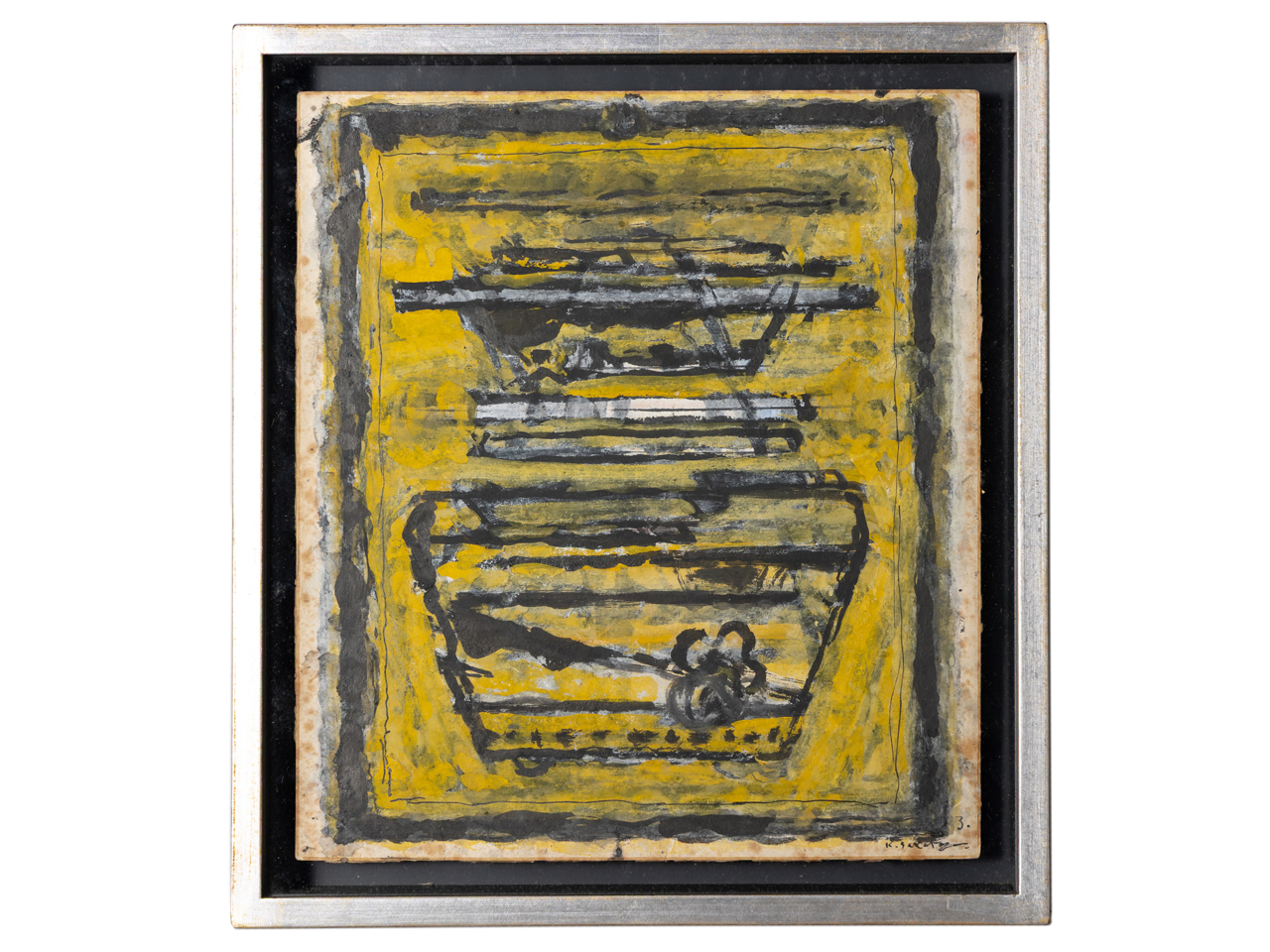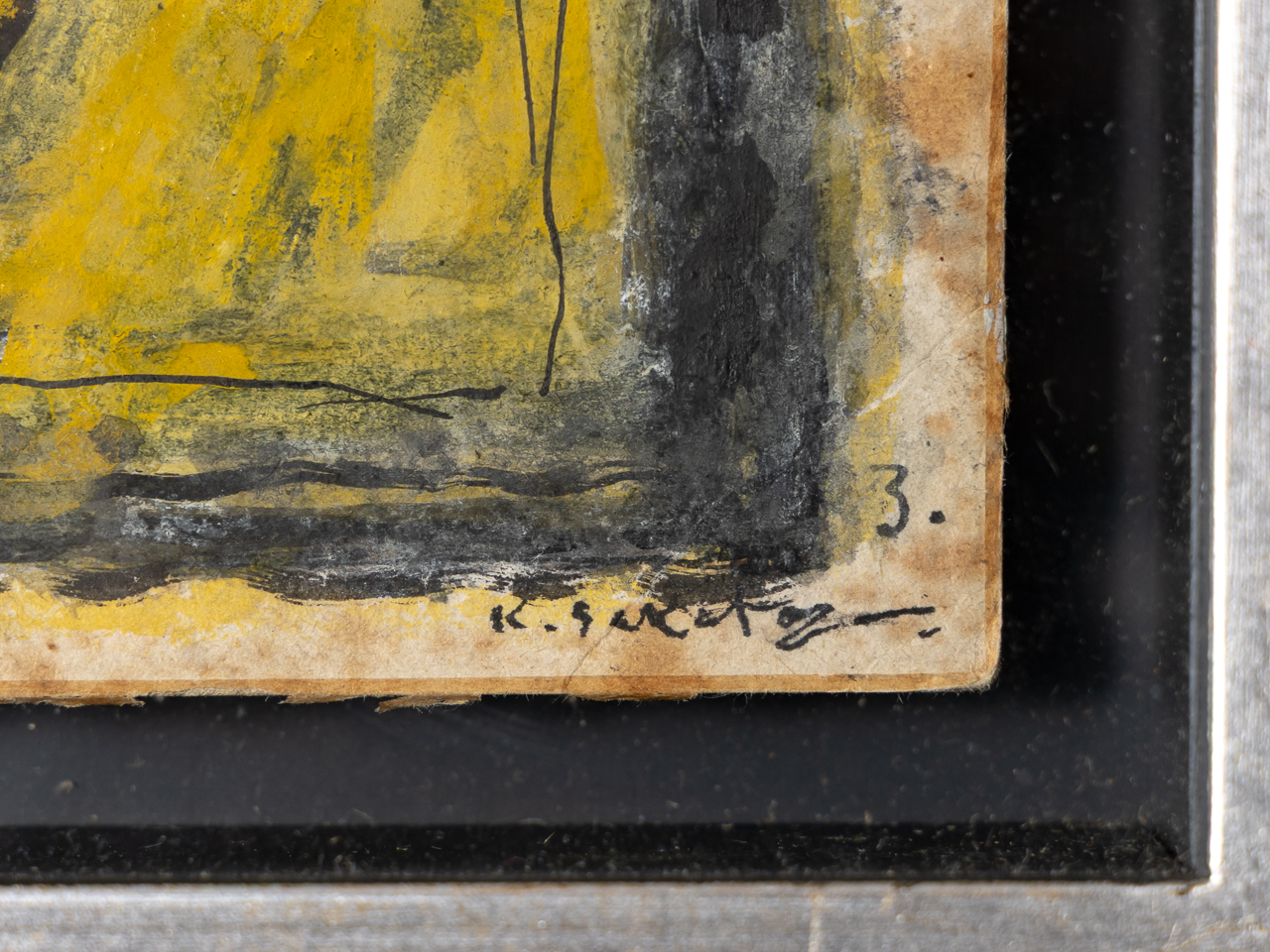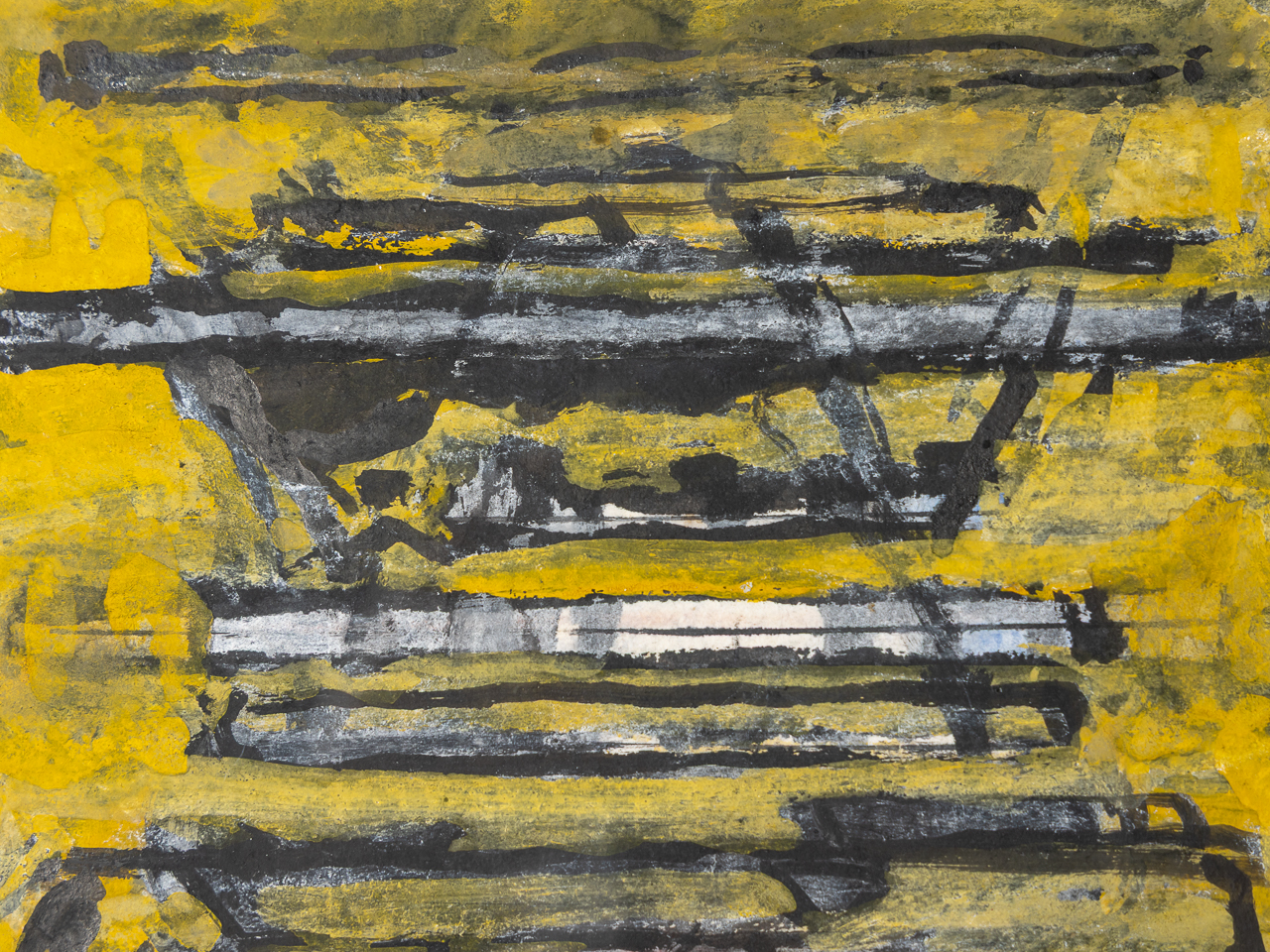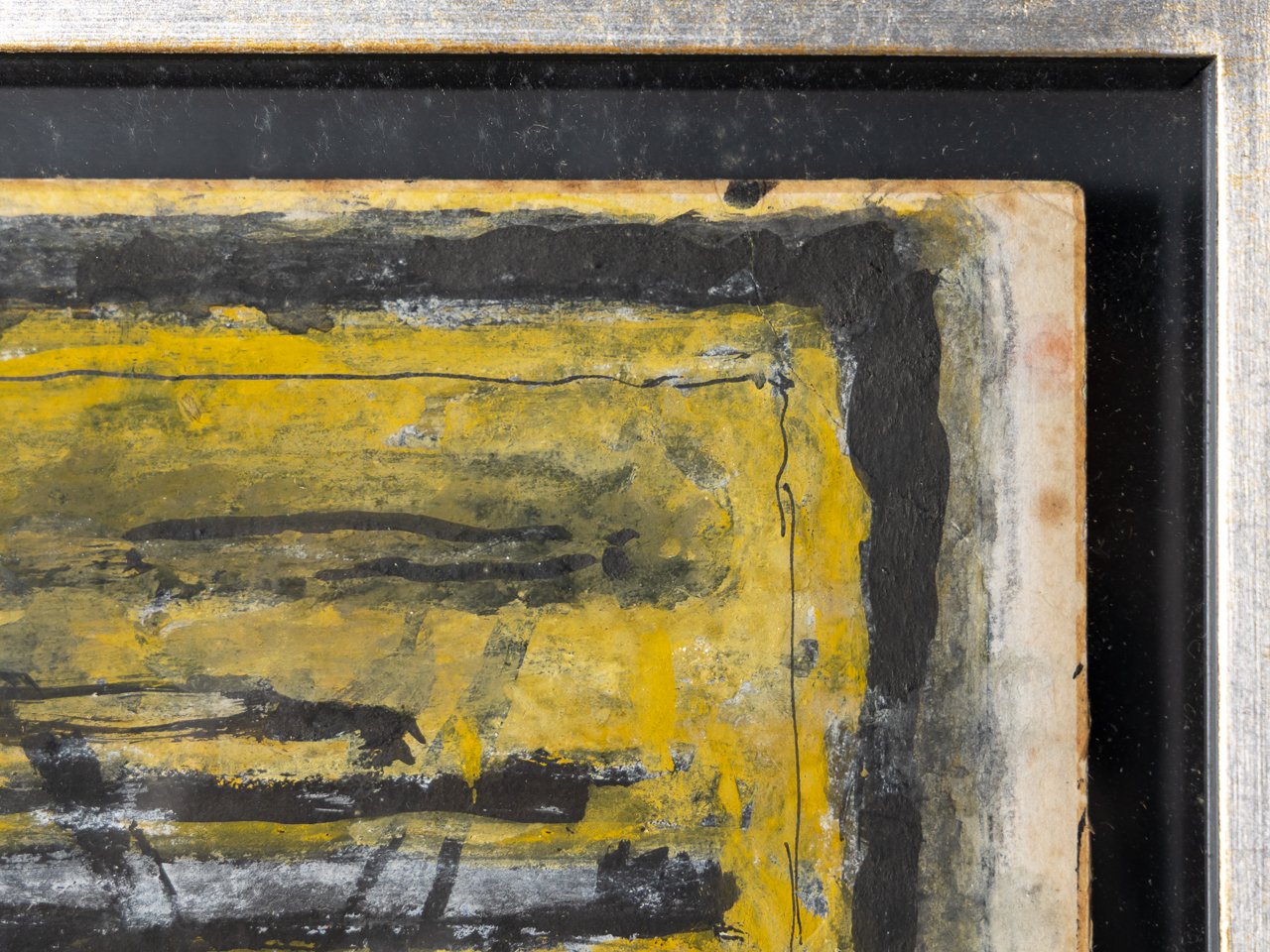坂田 一男/Sakata Kazuo
1920年代にパリに渡り、その最先端で活躍した坂田一男(1889~1956)は、近年再評価の機運が高まっている抽象画家です。
岡山県船頭町にて医学者の息子として生まれた坂田は、自身も医者を志したものの高等学校受験の度重なる失敗をきっかけに病気を患ってしまいます。しかし、療養中に洋画家の阿藤秀一郎(1888~1972)から木炭画を学んだのをきっかけに、画家の道へと転身を図ります。1914年に上京すると、本郷絵画研究所では岡田三郎助(1869~1939)、川端画学校では藤島武二(1867~1943)と、近代洋画の重鎮たちから手ほどきを受け、技術を磨いていきました。
第一次世界大戦後、1921年に渡仏してからは、アカデミー・モデルヌにてフォーヴィスムの画家であるオトン・フリエス(1879~1949)のもとで指導を受けるも物足りなさを感じ、その1年後にはキュビスムの画家として知られるフェルナン・レジェ(1881~1955)の教室に通うようになります。生涯の師となるレジェからは多大な影響を受けており、とりわけ創作における知性の必要性を意識し、造形を徹底的に分析して知的な画面をつくりあげるキュビスムを正しく学んだことは、日本の近代美術史における彼の位置づけを特異なものにしています。フォーヴィスムやシュルレアリスムといった西欧美術のトレンドをいち早く移植していた日本において、キュビスムにきちんと取り組んだ画家はきわめて少ないためです。パリ時代の坂田の作品は、キュビスムへの接近が窺える【裸婦】(1924年)や円錐型の組み合わせで人体を表現した【キュビスム的人物像】(1925年)、厳格な構成が際立つピュリスム風の【座る女Ⅳ】(1926年)などの抽象画がほとんどです。こうした作風や、コンパスや機械的要素といったモチーフを取り入れていた点はレジェの影響を色濃く感じさせますが、師が用いた明快な色彩よりも抑制されたモノクロームを好み、にじみやかすれなどの表情を含む自由な線を引いたところには坂田の独自性がはっきりと表れています。
1933年に帰国するものの、中央集権的な体制をきらい、自由を求めた坂田は日本の画壇を避けて岡山に戻り、倉敷市玉島に構えたアトリエにこもって新しい造形の探究に没頭しました。最晩年には、【コンポジション(メカニック・エレメント)】(1955年)のように、一見地味な単色のなかに多様なグレーが散りばめられた下地と、繊細で豊かな線による抽象画にたどりつきます。制作のかたわら、前衛美術グループ「アヴァンギャルド岡山(A.G.O)」を主宰して後進の育成にも励み、若手作家たちには「作品は絶対にオリジナルであること」を強く求めました。
当時の日本でキュビスムがあまり浸透しなかったこと、坂田が世俗的な評価を求めず中央画壇から距離を置いたこと、二度にわたる水害で多くの作品が失われたことなどにより、キュビスムのその先にある造形を突き詰めた彼の先鋭性、独自性は、生前ほとんど認知されていませんでした。没後、1957年のブリヂストン美術館における遺作展を契機に、忘れ去られていたその仕事や功績がようやく日の目を見ることとなり、現在では国内外における同時代の作家との比較を通して研究が進められています。
Kazuo Sakata (1889-1956), an abstract painter whose work has seen a growing reappraisal in recent years, traveled to Paris in the 1920s and flourished at the forefront of the avant-garde scene.
Born in Funado Town, Okayama Prefecture, the son of a medical practitioner, Sakata initially aspired to follow his father’s path. However, repeated failures in his high school entrance exams triggered an illness. During his recovery, he began studying charcoal drawing under the Western-style painter Shūichirō Ato (1888-1972), which prompted his shift toward a career as an artist. Moving to Tokyo in 1914, he honed his skills with leading figures in modern Western-style painting: Saburōsuke Okada (1869-1939) at the Hongō Painting Institute and Takeji Fujishima (1867-1943) at the Kawabata Painting School.
After the First World War, he traveled to France in 1921. Initially, he studied under the Fauvist painter Othon Friesz (1879-1949) at the Académie Moderne, but found the experience unsatisfying. A year later, he entered the studio of Fernand Léger (1881-1955), the renowned Cubist master, who became his lifelong mentor and exerted a profound influence. Crucially, Sakata correctly learned Cubism—an approach that emphasized intellectual creation through the rigorous analysis of form to construct reasoned compositions. This gave him a unique position in the history of modern Japanese art, as very few Japanese painters properly engaged with Cubism, despite the country’s quick adoption of other Western trends like Fauvism and Surrealism.
Sakata’s works from his Paris period are predominantly abstract, such as the Nude (1924), which hints at a Cubist approach; the Cubist Figure (1925), expressing the human form through conical shapes; and the Seated Woman IV (1926), notable for its strict, Purism-style composition. While this style and his inclusion of motifs like compasses and mechanical elements strongly suggest Léger’s influence, Sakata’s distinctiveness is clearly evident: he favored restrained monochrome over his mentor’s vivid colors, and his free, expressive lines often incorporated blurring and smudging.
Returning to Japan in 1933, Sakata deliberately avoided the Japanese art world, disliking its centralized structure and seeking artistic freedom. He settled in Okayama, secluding himself in his studio in Tamashima, Kurashiki City, to immerse himself in the exploration of new forms. In his final years, he developed an abstract style characterized by a deceptively plain monochrome ground, flecked with diverse shades of gray, and delicate yet rich lines, exemplified by works such as Composition (Mechanic Element). Beyond his own practice, he founded the avant-garde art group “Avant-Garde Okayama (A.G.O)” and devoted himself to mentoring younger artists, consistently stressing the need for absolute originality in their work.
His avant-garde approach, which pushed beyond Cubism to explore new forms of plastic art, and his unique artistic vision remained largely unrecognised during his lifetime. This was due to several factors: Cubism failed to gain significant traction in Japan; Sakata deliberately distanced himself from the mainstream art world, seeking no popular acclaim; and two major floods destroyed many of his works. Following his death, a posthumous exhibition at the Bridgestone Museum of Art in 1957 finally brought his forgotten work and achievements to light. Today, scholarly research continues to progress through comparisons with his contemporaries both in Japan and abroad.






作品名:作品
サイズ:27×24cm(紙にグワッシュ)
価格:ASK
価格は税抜き表示です

